Deformation and Instability Mechanisms of a Shaft and Roadway Under the Influence of Rock Mass Subsidence
Abstract
1. Introduction
2. Establishment and Calculation Process of a Numerical Model
2.1. Selection of Computing Software
2.2. Establishment of Numerical Model and Parameter Settings
- (1)
- Establishment of numerical model
- (2)
- Setting of model parameters
2.3. Setting of Constitutive Model for Numerical Simulation
2.4. Numerical Simulation Scheme
3. Simulation Results and Analysis
3.1. Overall Three-Dimensional Displacement Field of the Model
3.1.1. Overall Z-Direction Displacement Field of the Model
3.1.2. Overall X and Y-Direction Displacement Fields of the Model
3.2. Overall Three-Dimensional Stress Field of the Model
3.3. Three Directional Displacement Field of the Shaft
3.4. Three Directional Stress Fields of the Shaft
3.5. Distribution of Mises Equivalent Stress for Shaft
4. Discussion
4.1. Overall Failure Mode of the Model
4.2. Failure Mode of the Shaft Wall
4.3. Failure Mechanism of the Shaft Wall
5. Conclusions
- (1)
- The pulling effect on the overlying rock mass and shaft increases with greater roof subsidence displacement. Vertical displacement diminishes from the junction with the horsehead roadway to the model’s apex, with Z-direction displacement at 100 m above the roadway being about one-fifth of the roof’s MSD.
- (2)
- As roof subsidence displacement increases, the disturbance range of the overlying rock, shaft failure extent, and tensile failure units rise. With MSD transitions from 0.5 m to 1.5 m, the shaft failure range characterized by Mises equivalent stress expands. Tensile failure evolves from scattered occurrences to large-scale uniform distributions.
- (3)
- Shaft failure results from instability and deformation in the horsehead and connecting roadways, compounded by geological conditions. Situated in soft rock or fractured coal-bearing strata, excavation-induced disturbances lead to bending and deformation of thin bedrock, affecting the interface with loose layers and resulting in shaft rupture.
- (4)
- To prevent shaft damage from mining subsidence and water drainage, establishing protective coal pillars around the shaft and enhancing support strength at the base of the shaft parking area is recommended.
Author Contributions
Funding
Institutional Review Board Statement
Informed Consent Statement
Data Availability Statement
Conflicts of Interest
References
- Han, J.H.; Zou, J.Q.; Hu, C.C.; Yang, W.H. Deflection mechanism and safety analysis of coal mine shaft in deep soil Strata. Math. Probl. Eng. 2019, 2019, 9461742. [Google Scholar] [CrossRef]
- Liu, S.Q.; Jie, Y.X.; Xu, Y.C. Prevention of mine-shaft failure by aquifer replenishment. J. Test. Eval. 2017, 45, 890–903. [Google Scholar] [CrossRef]
- Yan, H.; Zhang, J.X.; Zhou, N.; Zhang, S.; Dong, X.J. Shaft failure characteristics and the control effects of backfill body compression ratio at ultra-contiguous coal seams mining. Environ. Earth Sci. 2018, 77, 458. [Google Scholar] [CrossRef]
- Zhang, W.; He, Z.M.; Zhang, D.S.; Qi, D.H.; Zhang, W.S. Surrounding rock deformation control of asymmetrical roadway in deep three-soft coal seam: A case study. J. Geophys. Eng. 2018, 15, 1917–1928. [Google Scholar] [CrossRef]
- Bukowski, P. Water hazard assessment in active shafts in upper silesian coal basin mines. Mine. Water. Environ. 2011, 30, 302–311. [Google Scholar] [CrossRef]
- Shi, H.; Zhang, H.Q.; Chen, W.L.; Song, L.; Li, M. Pull-out debonding characteristics of bolt with prefabricated cracks in rock: A numerical study based on Particle Flow Code. Comput. Part. Mech. 2024, 11, 29–53. [Google Scholar] [CrossRef]
- Zhang, W.Q.; Wang, Z.Y.; Shao, J.L.; Zhu, X.X.; Li, W.; Wu, X.T. Evaluation on the stability of vertical mine shafts below thick loose strata based on the comprehensive weight method and a fuzzy matter-element analysis model. Geofluids 2019, 2019, 3543957. [Google Scholar] [CrossRef]
- Shi, H.; Chen, W.L.; Zhang, H.Q.; Song, L.; Li, M.; Wang, M.J.; Lu, P.J. Dynamic strength characteristics of fractured rock mass. Eng. Fract. Mech. 2023, 292, 109678. [Google Scholar] [CrossRef]
- Abdulridha, H.L.; Abdulaziz, A.M.; Khalil, A.A.; Alhussainy, S.; Abd Askar, A.S.; Dahab, A.S.A.; Alfarge, D. Study on uncertainty analysis for drilling engineering applications: Wellbore stability assessments. Arab. J. Sci. Eng. 2022, 47, 11687–11698. [Google Scholar] [CrossRef]
- Han, J.H.; Zou, J.Q.; Hu, C.C.; Yang, W.H. Study on size design of shaft protection rock/coal pillars in thick soil and thin rock strata. Energies 2019, 12, 2553. [Google Scholar] [CrossRef]
- Sun, X.M.; Zhu, M.Q.; Zhang, Y.; Zhao, C.W.; Miao, C.Y.; Zhang, S.K. Highly prestressed NPR cable coupling support technology and its application in the deep roadway. Eng. Fail. Anal. 2022, 142, 106707. [Google Scholar] [CrossRef]
- Wu, J.Y.; Wong, H.S.; Zhang, H.; Yin, Q.; Jing, H.; Ma, D. Improvement of cemented rockfill by premixing low-alkalinity activator and fly ash for recycling gangue and partially replacing cement. Cem. Concr. Comp. 2024, 145, 105345. [Google Scholar] [CrossRef]
- Dobson, J.A.; Riddiford-Harland, D.L.; Bell, A.F.; Wegener, C.; Steele, J.R. Effect of work boot shaft stiffness and sole flexibility on lower limb muscle activity and ankle alignment at initial foot-ground contact when walking on simulated coal mining surfaces: Implications for reducing slip risk. Appl. Ergon. 2019, 81, 102903. [Google Scholar] [CrossRef]
- Li, P.X.; Zhu, X.Y.; Ding, X.C.; Zhang, T. An experimental study of industrial site and shaft pillar mining at Jinggezhuang coal mine. Appl. Sci. 2023, 13, 2340. [Google Scholar] [CrossRef]
- Szlązak, N.; Korzec, M. Conditions that determine changing the function of mine shafts in a gassy coal mine—A case study. Energies 2024, 17, 1379. [Google Scholar] [CrossRef]
- Wang, L.; Cheng, Y.P.; Ge, C.G.; Chen, J.X.; Wang, H.F. Safety technologies for the excavation of coal and gas outburst-prone coal seams in deep shafts. Int. J. Rock Mech. Min. 2013, 57, 24–33. [Google Scholar] [CrossRef]
- Cheng, H.; Su, J.; Tang, R.S. Fuzzy inversion of negative friction on shafts through de-watered subsiding grounds. J. Xi’an Inst. Min. Technol. 1999, 4, 309–312. (In Chinese) [Google Scholar]
- Lou, G.D.; Su, L.F. Analysis of loading on shaft lining subjected to alluvium settlement due to water drainage. J. China Coal Soc. 1991, 16, 54–62. (In Chinese) [Google Scholar]
- Yan, H.; Zhang, J.X.; Zhang, S.; Zhou, N. Physical modeling of the controlled shaft deformation law during the solid backfill mining of ultra-close coal seams. Bull. Eng. Geol. Environ. 2019, 78, 3741–3754. [Google Scholar] [CrossRef]
- Lu, Y.H.; Chen, M.; Jin, Y.; Ge, W.F.; An, S.; Zhou, Z. Influence of porous flow on wellbore stability for an inclined well with weak plane formation. Petrol. Sci. Technol. 2013, 31, 616–624. [Google Scholar] [CrossRef]
- Ma, T.S.; Chen, P. New method for calculating wellbore collapse pressure in shale formations. Chem. Tech. Fuels Oil. 2016, 52, 451–461. [Google Scholar] [CrossRef]
- Zhang, L.S.; Jiang, M.G.; Li, W.J.; Bian, Y.H. A new analytical model of wellbore collapse pressure based on stability theory. J. Petrol. Sci. Eng. 2020, 188, 106928. [Google Scholar] [CrossRef]
- Ma, Y.F.; Yu, R.G. New analytical methods to evaluate uncertainty of wellbore stability. J. Petrol. Sci. Eng. 2019, 180, 268–277. [Google Scholar] [CrossRef]
- Mu, K.H. Stress Mechanism Analysis and Safety Monitoring Research on Simultaneous Water Loss Shaft Wall of Upper and Lower Aquifers in Alluvium. Master’s Thesis, Anhui University of Science and Technology, Huainan, China, 2020. (In Chinese). [Google Scholar] [CrossRef]
- Wu, F.; Qin, Y.P.; Xu, H.; Zhang, F.J.; Chu, X.Y. Numerical simulation of deformation and failure mechanism of main inclined shaft in Yuxi coal mine, China. Appl. Sci. 2022, 12, 5531. [Google Scholar] [CrossRef]
- Yao, Z.S.; Yu, G.H.; Cheng, H.; Rong, C.X. Research on vertical bearing capacity of shaft lining structure of high strength concrete and double steel cylinders in super-thick alluvium. Rock Soil Mech. 2010, 31, 1687–1691. (In Chinese) [Google Scholar]
- Cui, S.; Liu, H.B.; Meng, Y.F.; Zhang, Y.N.; Tao, Y.; Zhang, X.N. Study on fracture occurrence characteristics and wellbore stability of limestone formation. J. Petrol. Sci. Eng. 2021, 204, 108783. [Google Scholar] [CrossRef]
- Gao, H.D.; An, B.F.; Han, Z.; Guo, Y.C.; Guo, Y.C.; Ruan, Z.Y.; Li, W.; Zayzay, S. The sustainable development of aged coal mine achieved by recovering pillar-blocked coal resources. Energies 2020, 13, 3912. [Google Scholar] [CrossRef]
- Hendel, J.; Lukanko, L.; Macuda, J.; Kosakowski, P.; Loboziak, K. Surface geochemical survey in the vicinity of decommissioned coal mine shafts. Sci. Total Environ. 2021, 779, 146385. [Google Scholar] [CrossRef]
- Zhang, J.P.; Li, K.S.; Li, Y.; Liu, C.X.; Xu, J.H.; He, J.P. Applying novel micro–Nano-Siliceous grouting material improves mechanical behaviors of fractured rock masses and microscopic characteristics of slurry–rock interface: Experimental and numerical simulation investigations. Rock Mech. Rock Eng. 2024, 57, 8297–8321. [Google Scholar] [CrossRef]
- Cui, J.F.; Wang, W.J.; Yuan, C. Application of stability analysis in surrounding rock control and support model of deep roadway. Int. J. Oil. Gas Coal T. 2022, 29, 180–192. [Google Scholar] [CrossRef]
- Gao, M.Z.; Zhou, X.M.; Wang, X.; Xie, J.; Wang, C.; Zhang, Q.; Lv, H.Q.; Guo, C.C. Mechanical behavior of coal under true triaxial loading test connecting the effect of excavation- and mining-induced disturbances. Geomech. Geophys. Geo-Energy Geo-Resour. 2023, 9, 34. [Google Scholar] [CrossRef]
- Wang, X.S.; Cheng, H.; Wu, T.L.; Yao, Z.S.; Huang, X.W. Numerical analysis of a novel shaft lining structure in coal mines consisting of hybrid-fiber-reinforced concrete. Crystals 2020, 10, 928. [Google Scholar] [CrossRef]
- Chen, S.M.; Wu, A.X.; Wang, Y.M.; Chen, X.; Yan, R.F.; Ma, H.J. Study on repair control technology of soft surrounding rock roadway and its application. Eng. Fail. Anal. 2018, 92, 443–455. [Google Scholar] [CrossRef]
- Emad, M.Z.; Mitri, H.; Kelly, C. Dynamic model validation using blast vibration monitoring in mine backfill. Int. J. Rock Mech. Min. 2018, 107, 48–54. [Google Scholar] [CrossRef]
- Lin, H.; Liu, T.Y.; Li, J.T.; Cao, P. A simple generation technique of complex geotechnical computational model. Math. Probl. Eng. 2013, 2013, 863104. [Google Scholar] [CrossRef]
- Wang, X.D.; Yu, Z.R.; Zhang, J.K.; Guo, Q.L.; Yang, S.L.; Sun, M.L. Numerical simulation of the behaviors of test square for prehistoric earthen sites during archaeological excavation. J. Rock Mech. Geotech. 2018, 10, 567–578. [Google Scholar] [CrossRef]
- Yang, R.S.; Li, Y.L.; Guo, D.M.; Yao, L.; Yang, T.M.; Li, T.T. Failure mechanism and control technology of water-immersed roadway in high-stress and soft rock in a deep mine. Int. J. Min. Sci. Technol. 2017, 27, 245–252. [Google Scholar] [CrossRef]
- Shi, H.; Zhang, H.Q.; Song, L.; Wu, Y. Variation of strata pressure and axial bolt load at a coal mine face under the effect of a fault. Arch. Min. Sci. 2019, 64, 351. [Google Scholar]
- Shi, H.; Song, L.; Zhang, H.Q.; Chen, W.L.; Lin, H.S.; Li, D.Q.; Wang, G.Z.; Zhao, H.Y. Experimental and numerical studies on progressive debonding of grouted rock bolts. Int. J. Min. Sci. Technol. 2021, 32, 63–74. [Google Scholar] [CrossRef]
- Wang, Y.; Song, L.; He, Y.S.; Wang, G.Z.; Wang, Q.R.; He, Y.M.; Li, S.D.; Xu, Q.G.; Zhu, R.; Zhang, W.Q.; et al. Similar simulation test study on the influence of mining on shaft deflection of deep soil based on hydraulic permeability model. Energy Explor. Exploit. 2023, 41, 19–43. [Google Scholar] [CrossRef]
- Deng, Z.; Zhu, Z.M.; Zhou, L.; Zhang, Y.; Zhang, H.D.; Nie, F.K.; Liu, B. Study on fracture characteristics of surrounding rock of twin tunnels under various crack inclination and location conditions. Int. J. Impact Eng. 2024, 194, 105084. [Google Scholar] [CrossRef]
- Zhao, J.J.; Zhu, Z.H.; Zhang, D.X.; Wang, H.; Li, X. Assessment of fabric characteristics with the development of sand liquefaction in cyclic triaxial tests: A DEM study. Soil Dyn. Earthq. Eng. 2023, 176, 108343. [Google Scholar] [CrossRef]
- Fan, L.; Wang, W.J.; Yuan, C.; Ma, Y.J. Research on the differentiated support technology for roadways based on the mechanical response of the plastic zone. Energy Sci. Eng. 2023, 12, 670–683. [Google Scholar] [CrossRef]
- Ma, Y.J.; Wang, W.J.; Fan, L.; Yuan, C.; Tian, X.Y.; Shu, S.H. Research on crack distribution characteristics and control technology of surrounding rock in soft rock roadway under different lateral pressure coefficients. Energy Sci. Eng. 2024, 12, 3852–3868. [Google Scholar] [CrossRef]

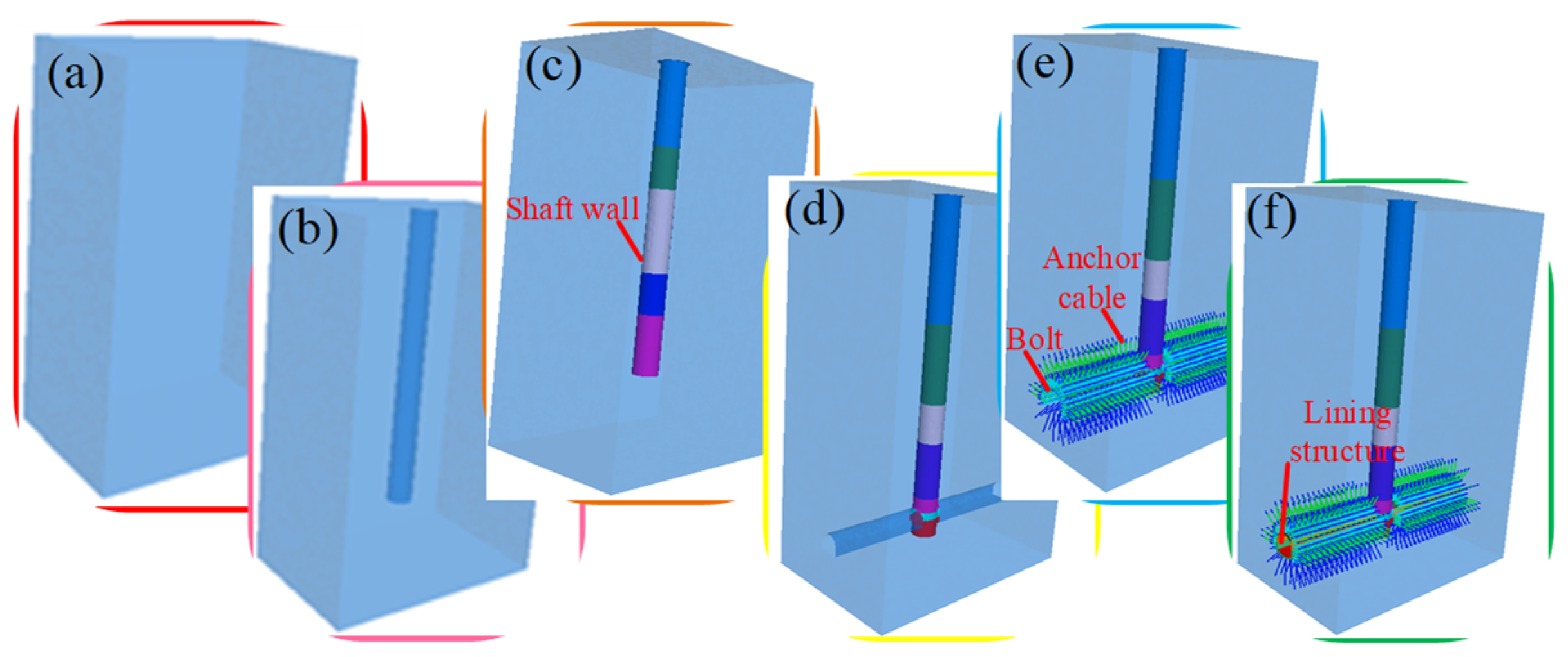
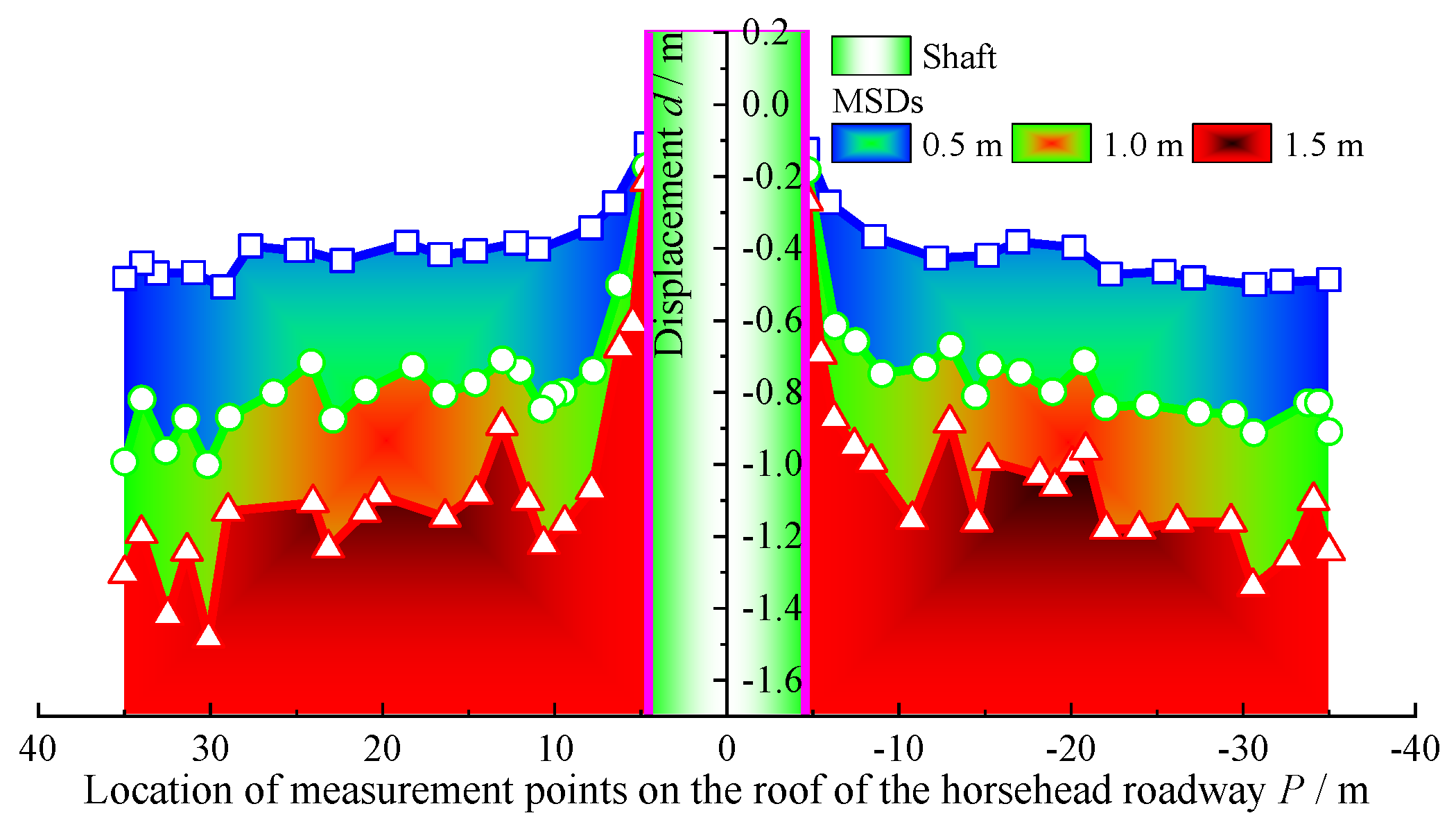
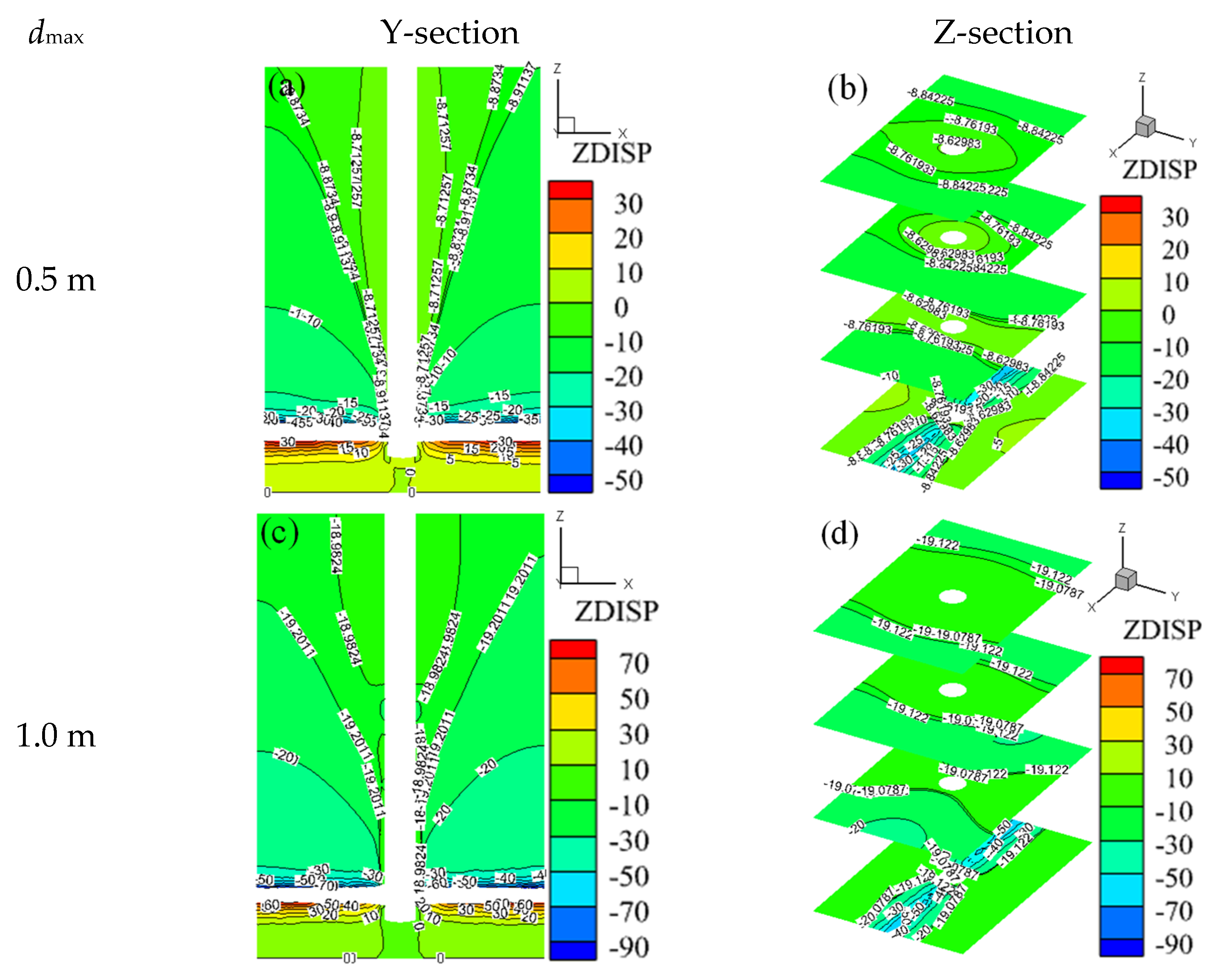
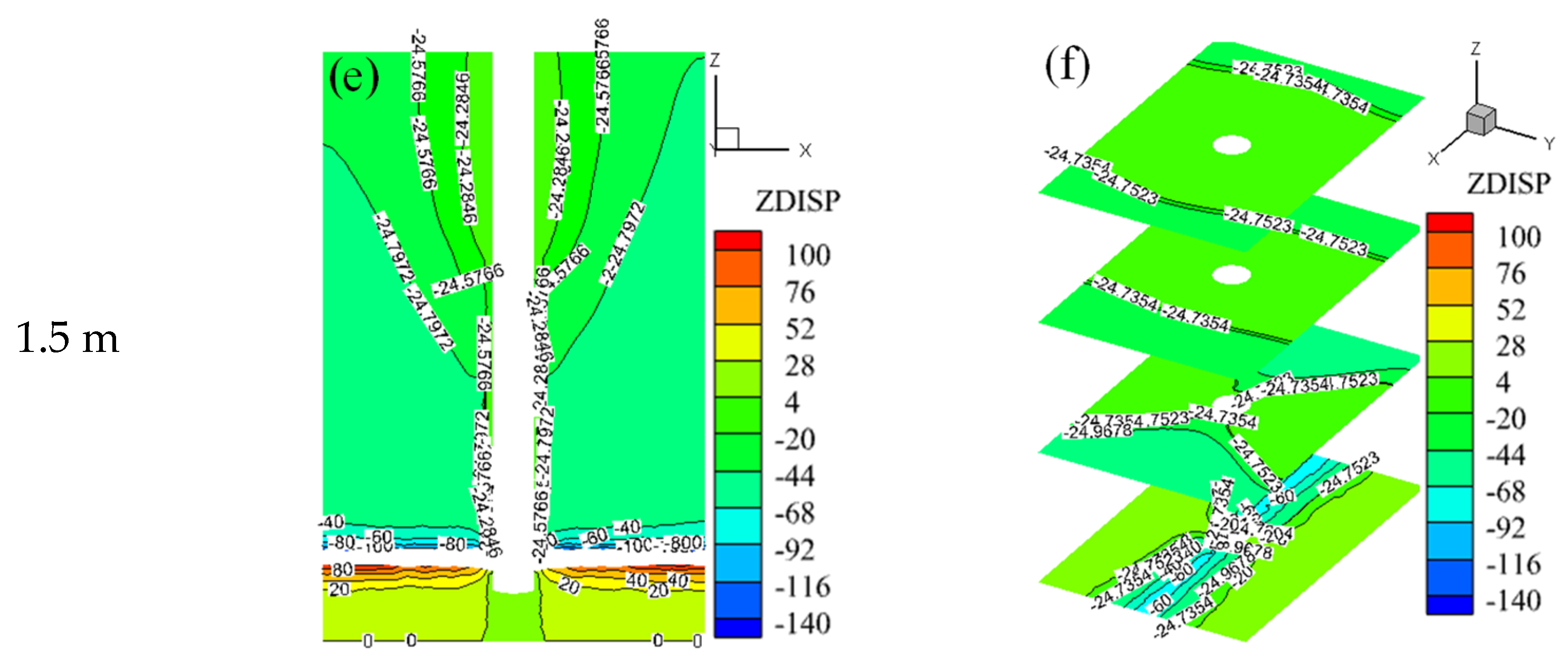
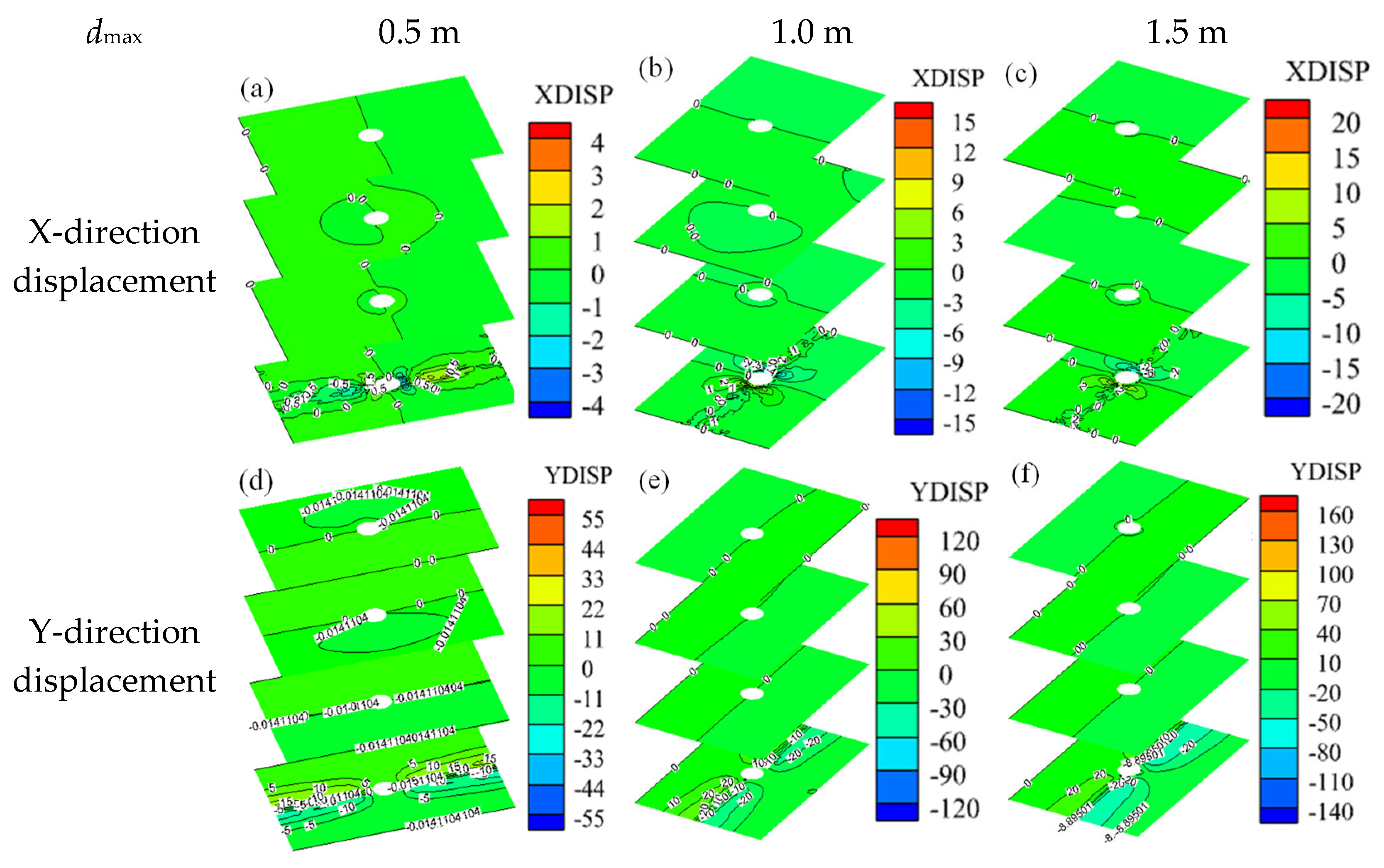
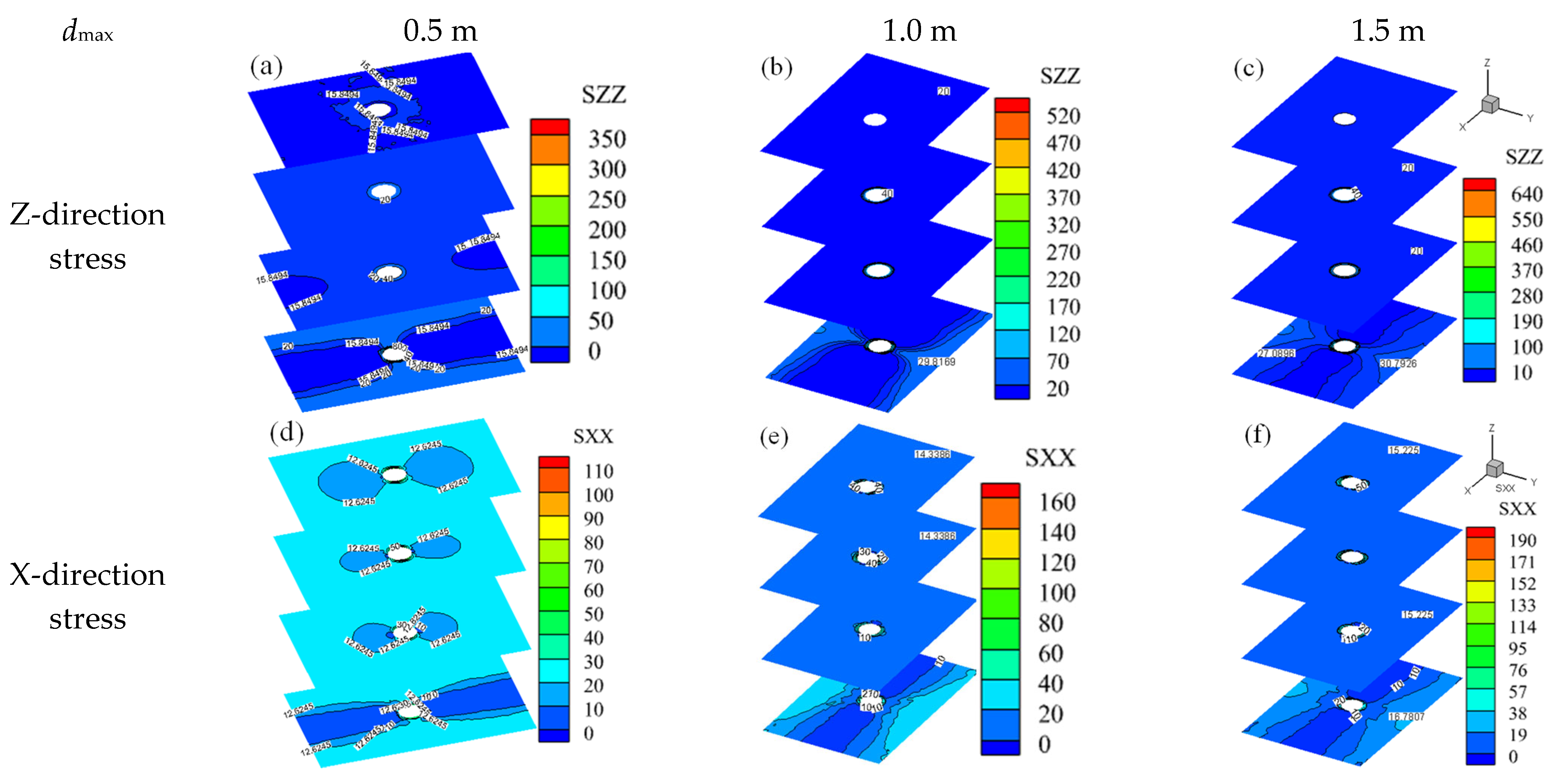

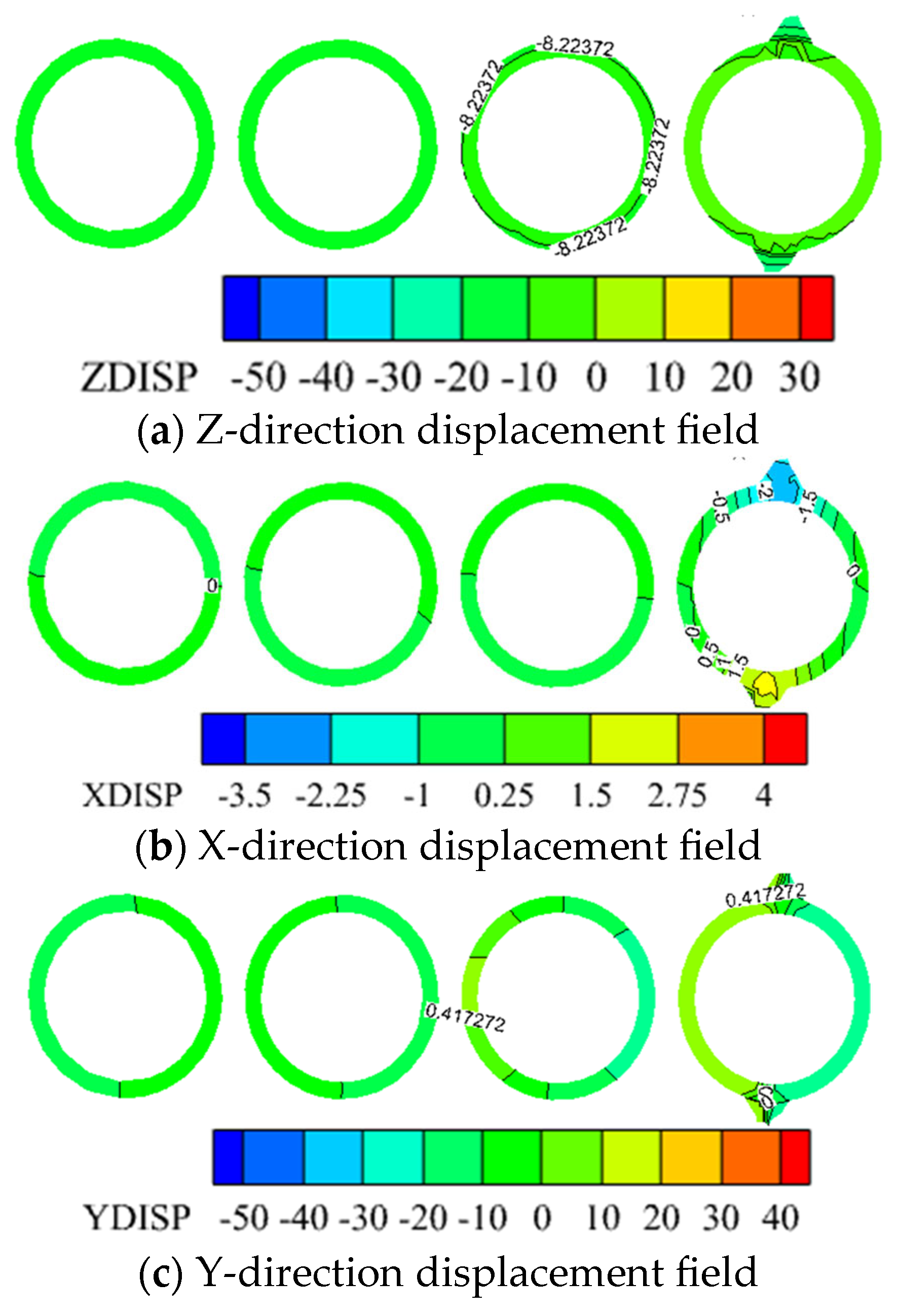
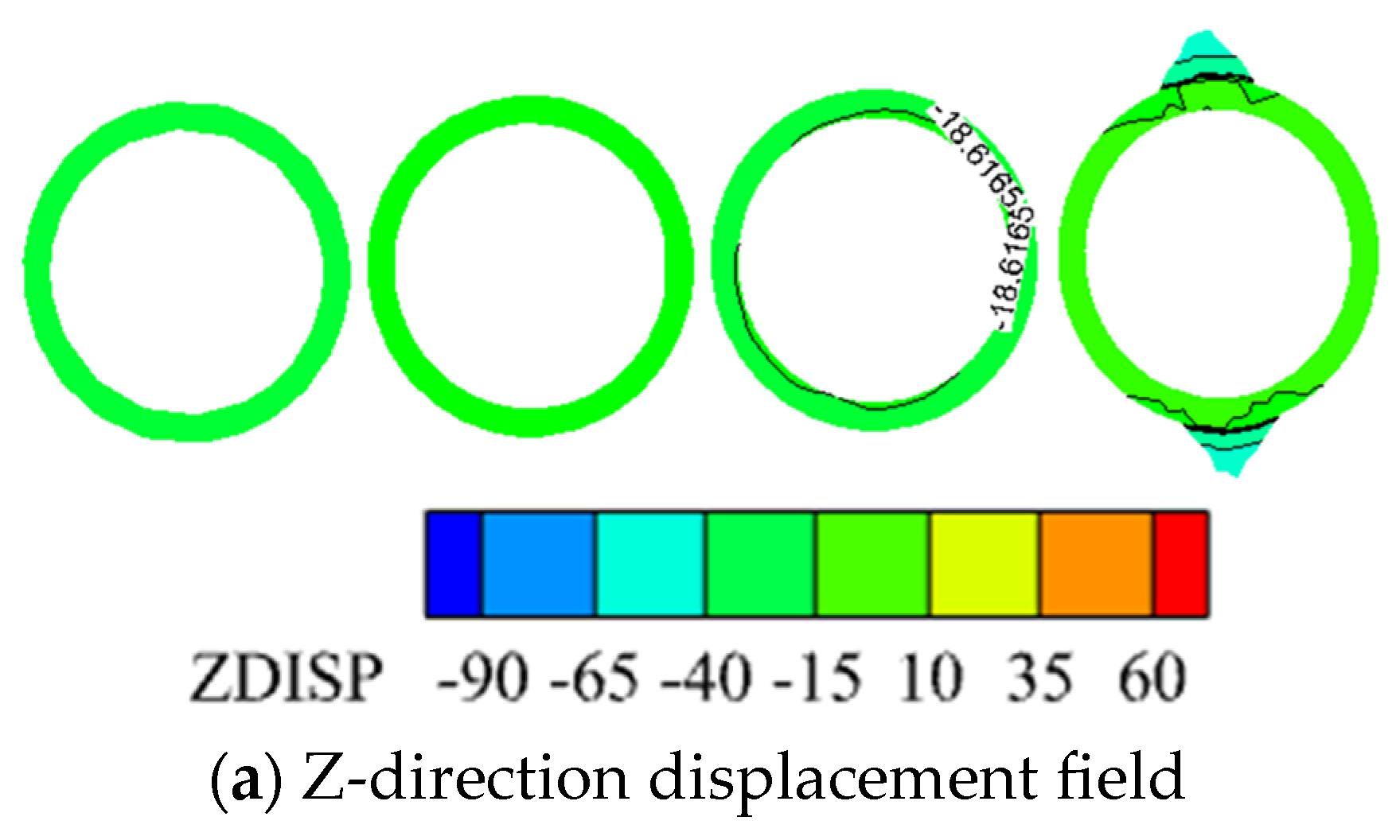
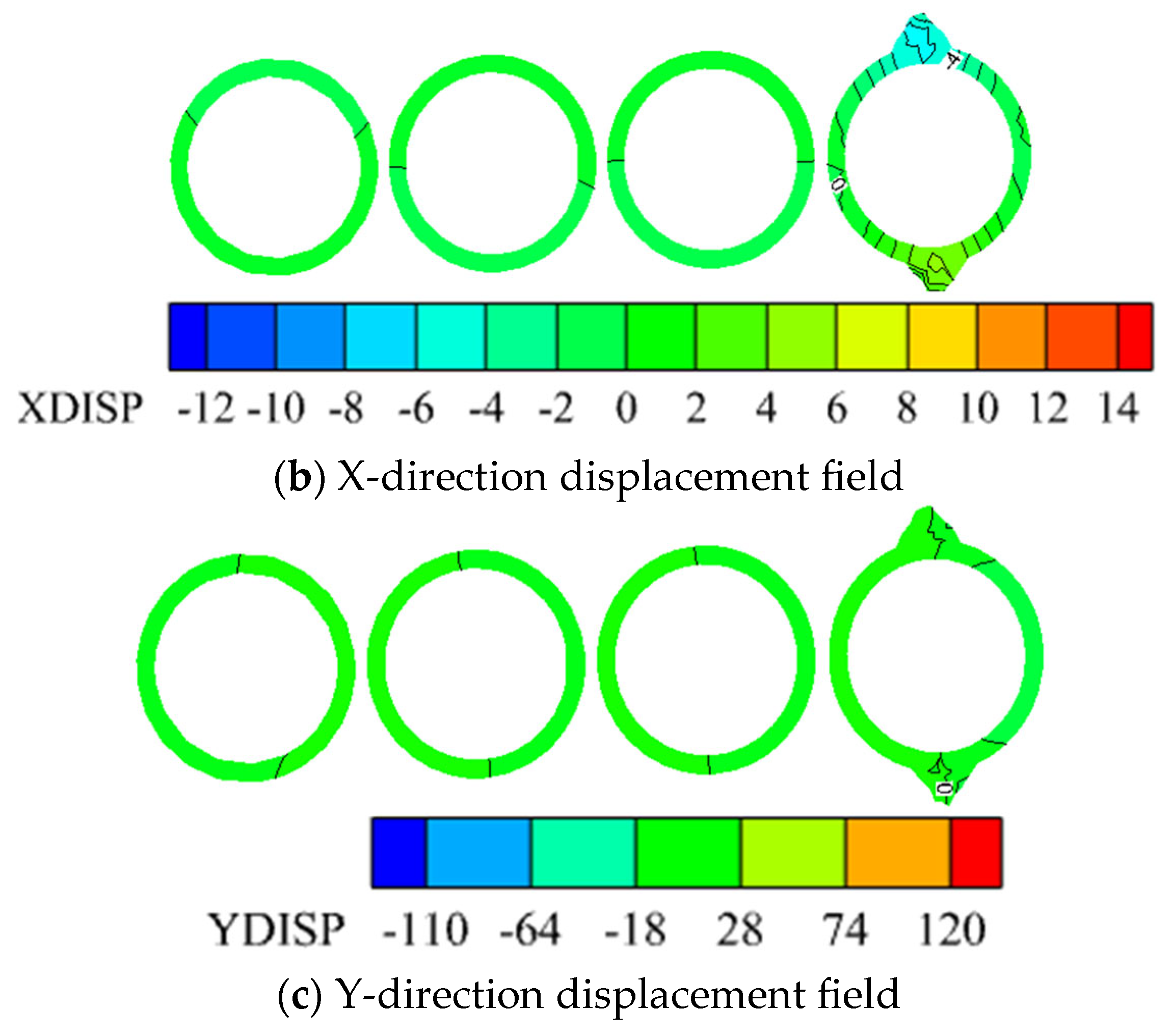
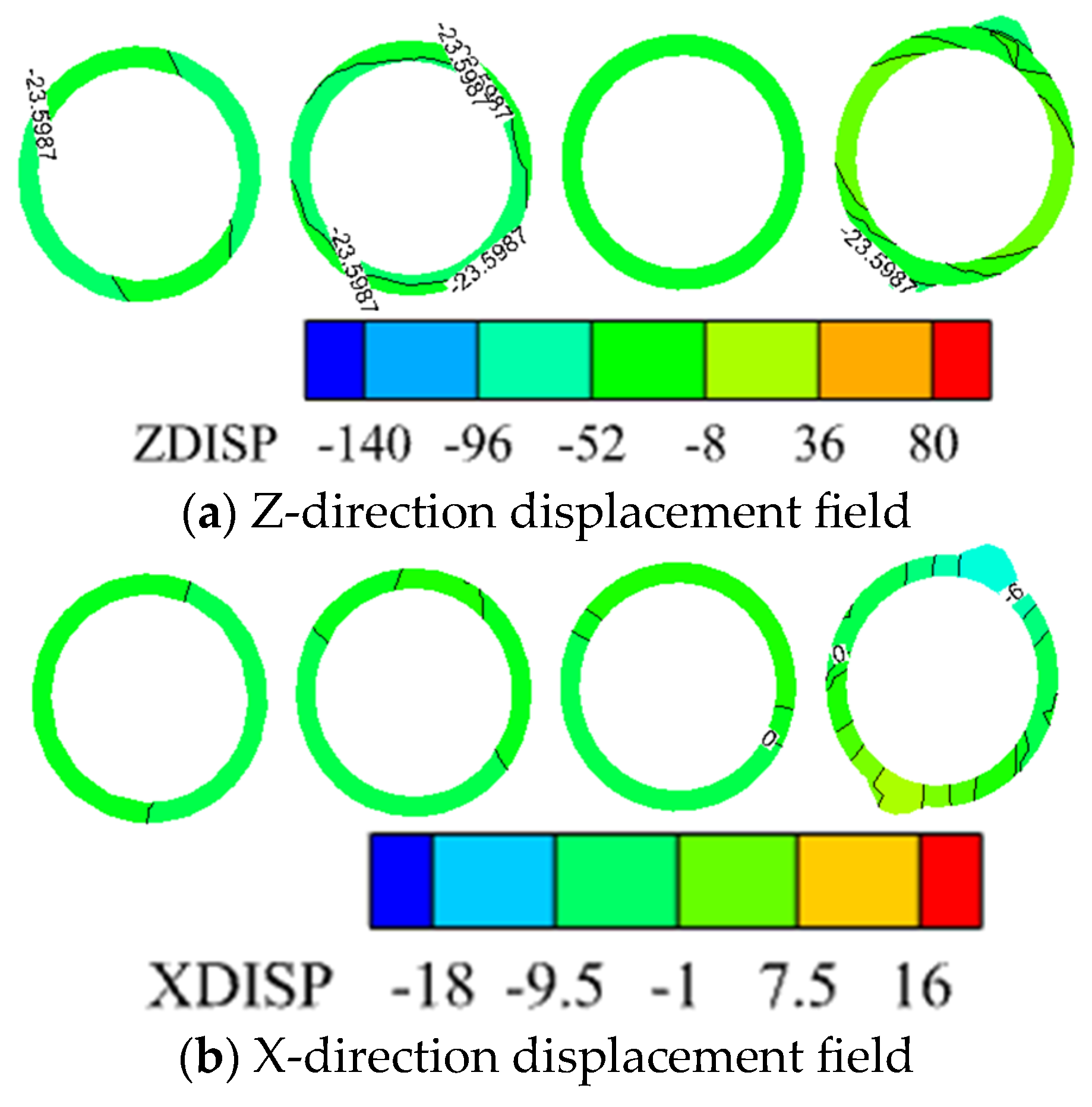
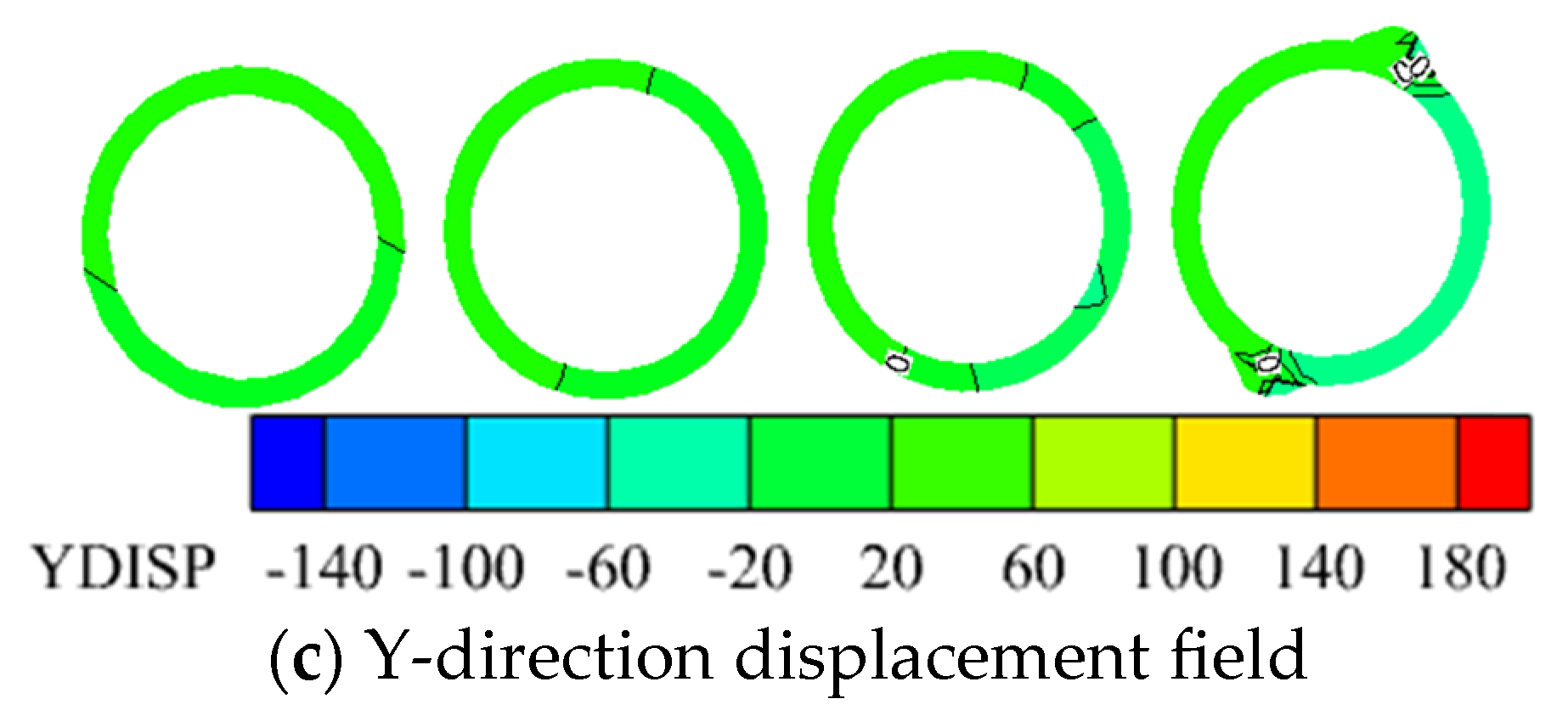
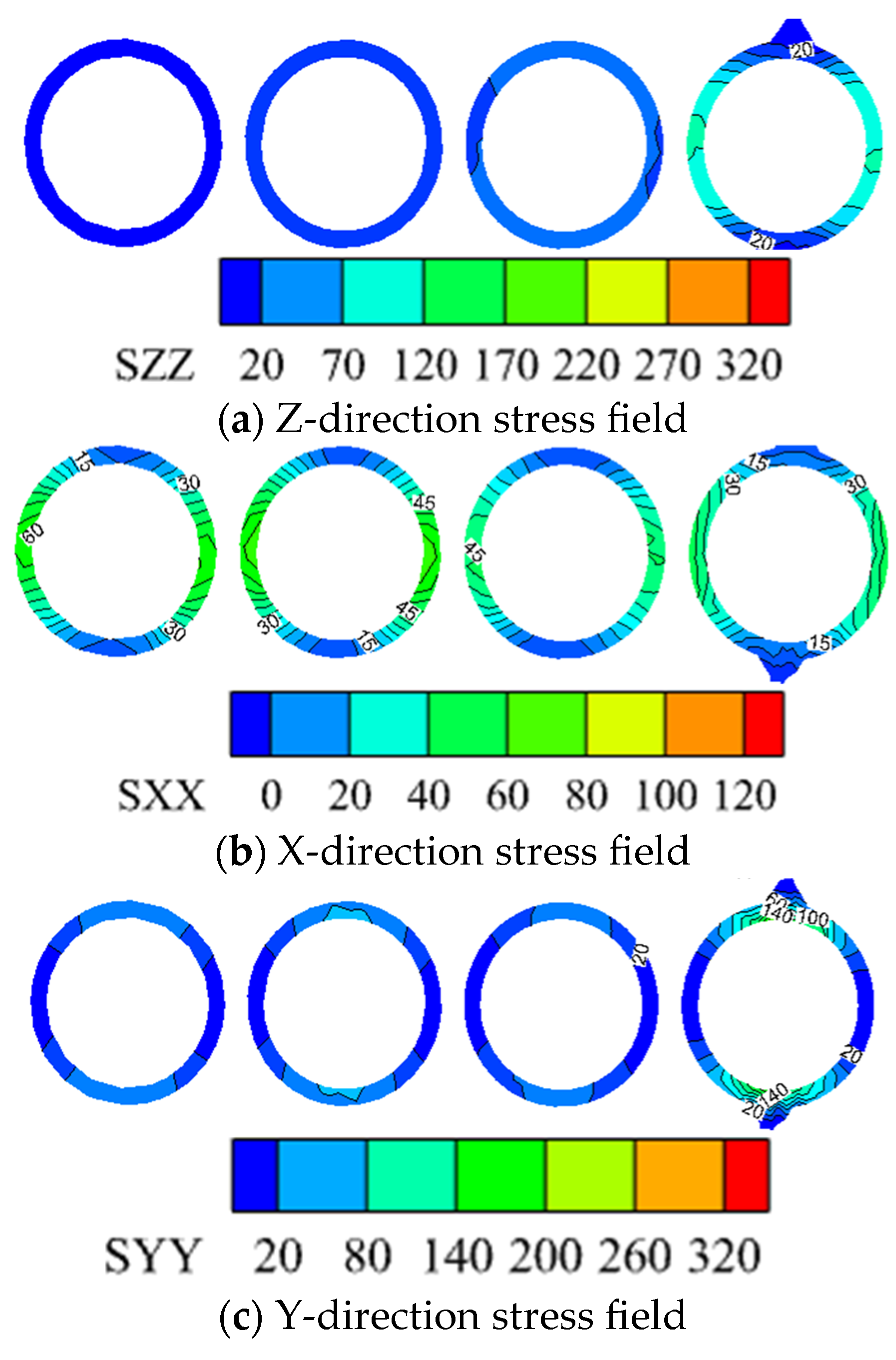
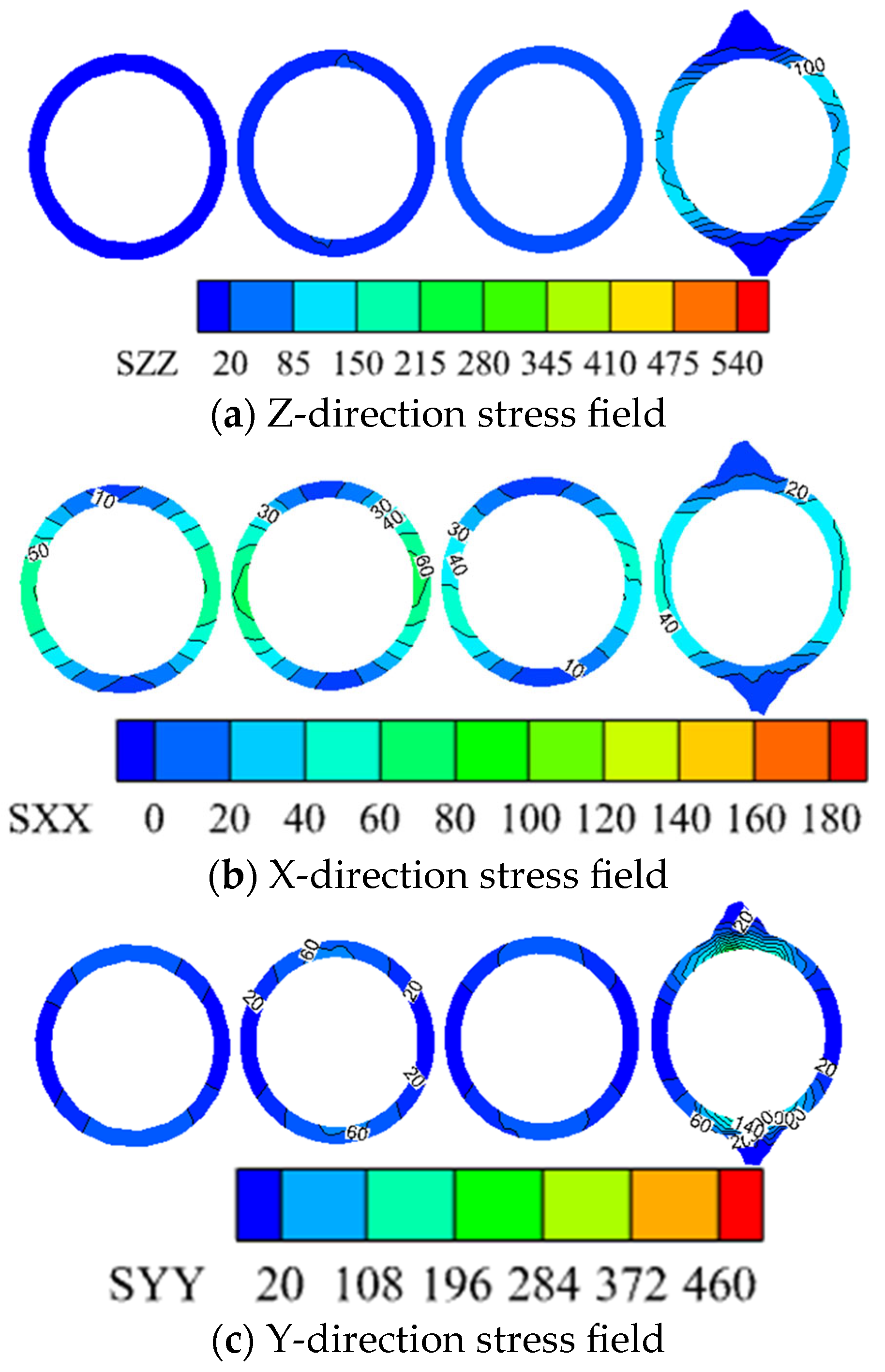
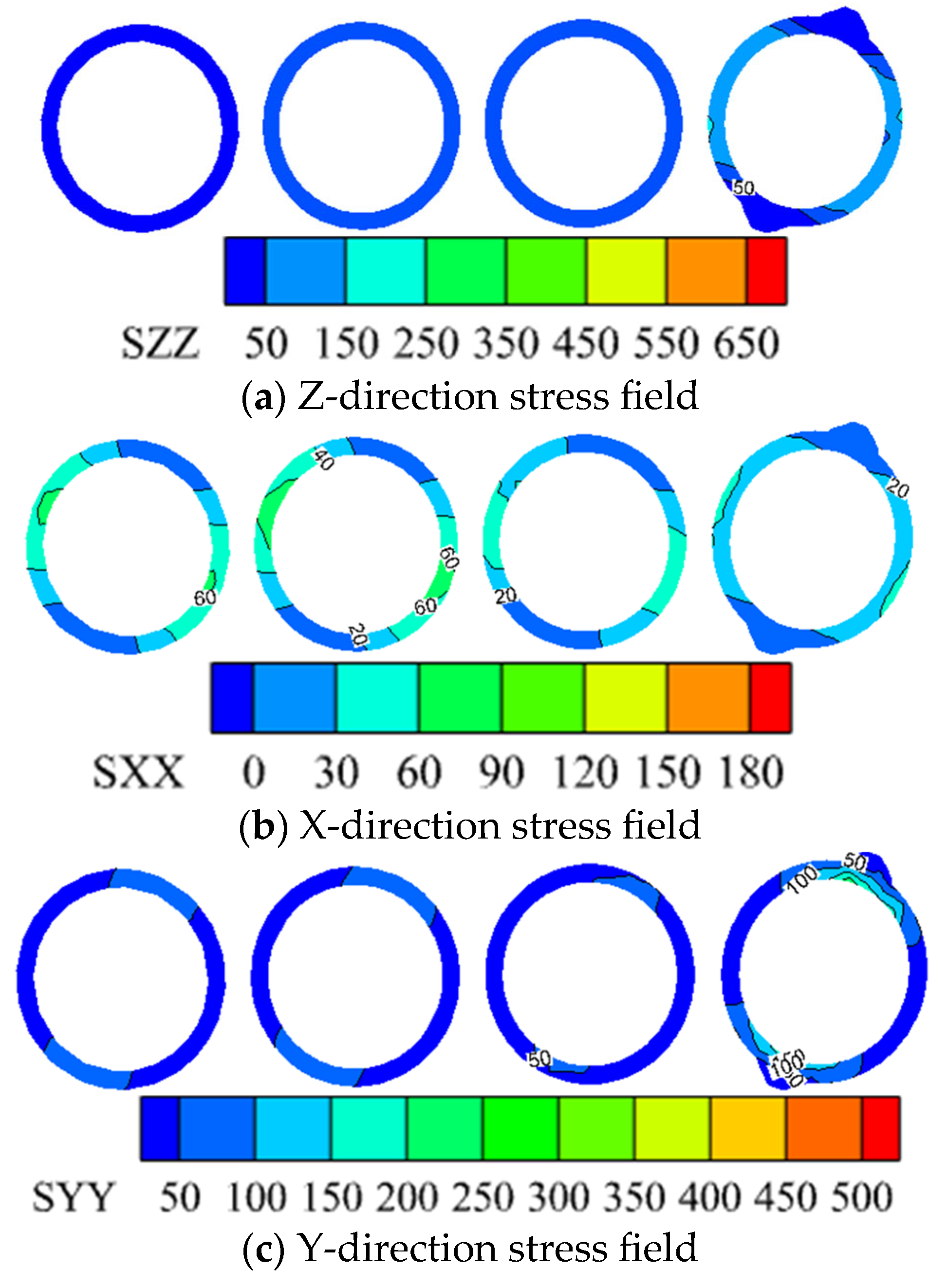
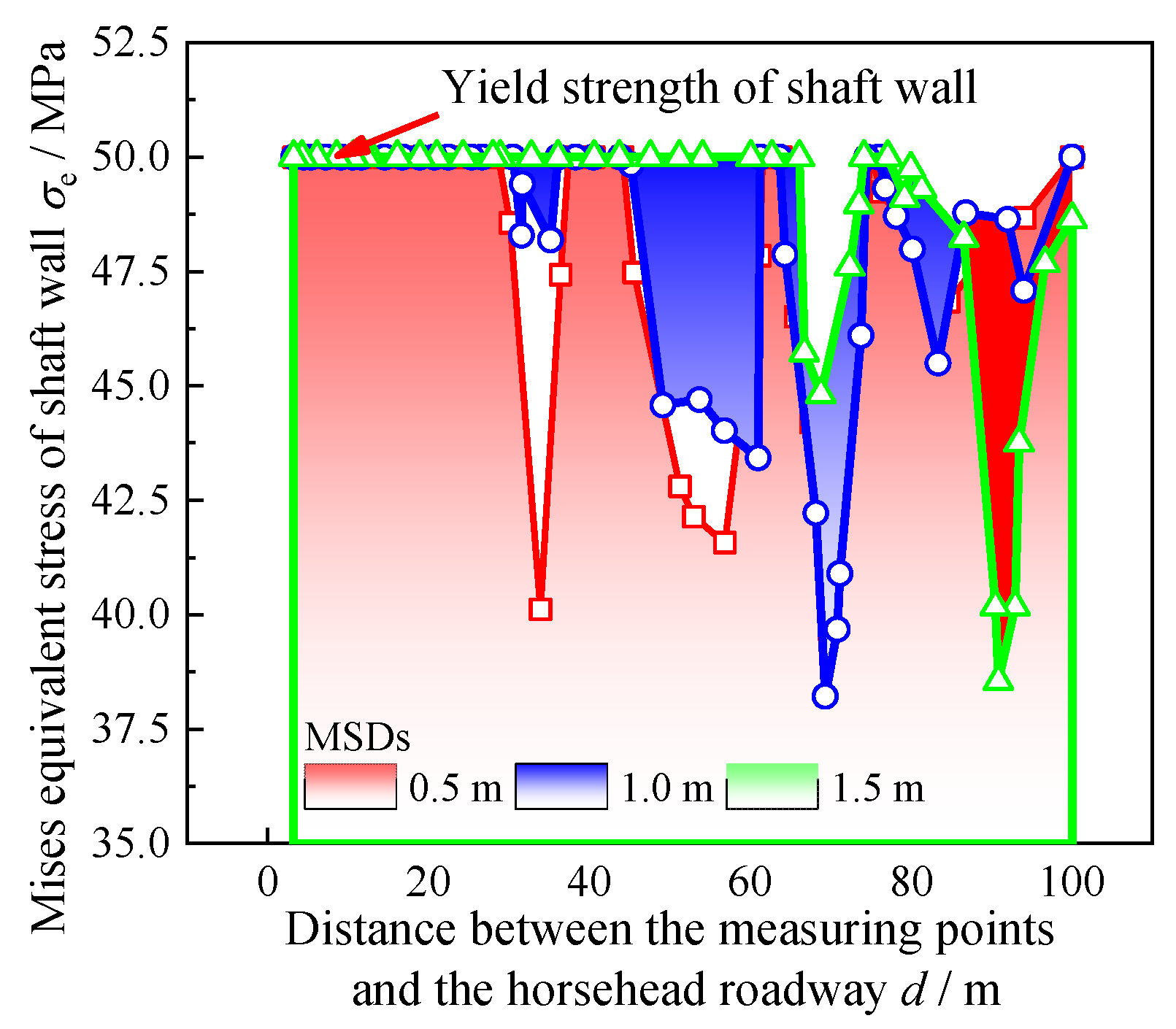
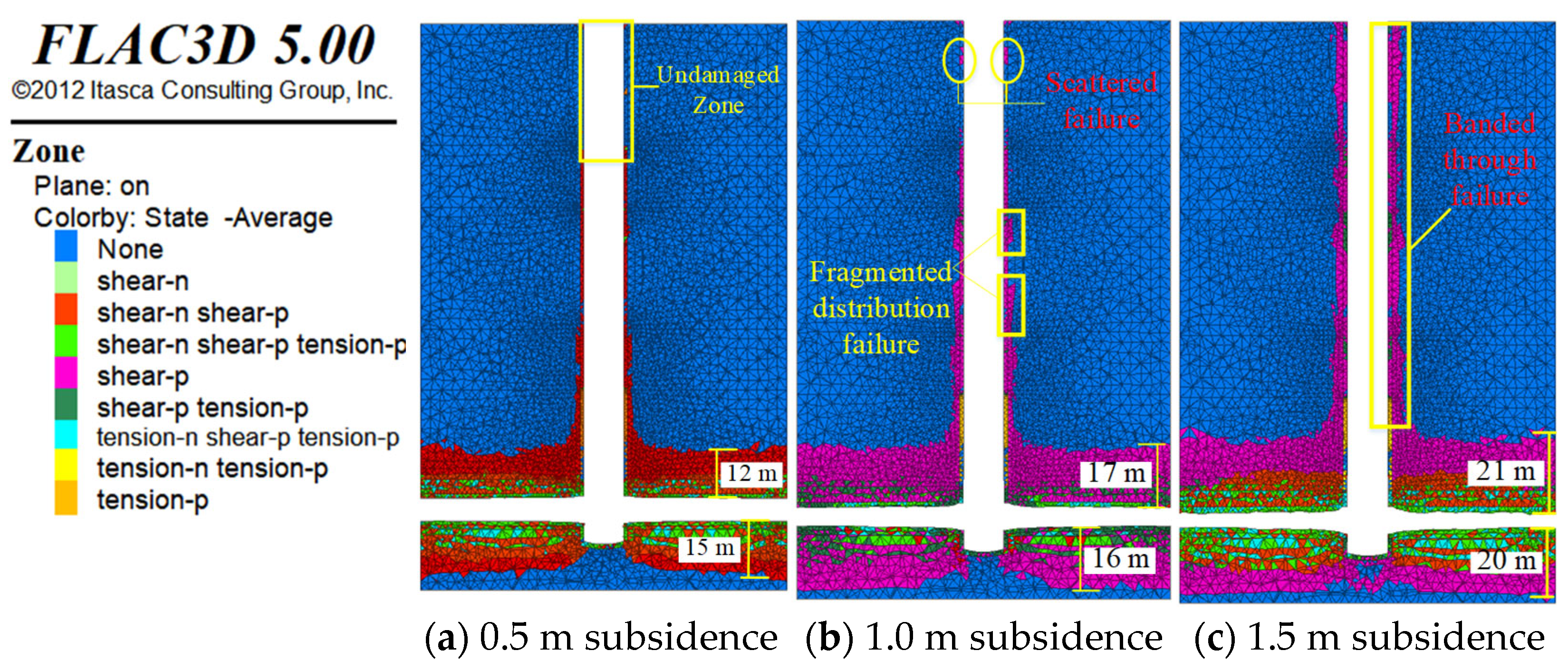
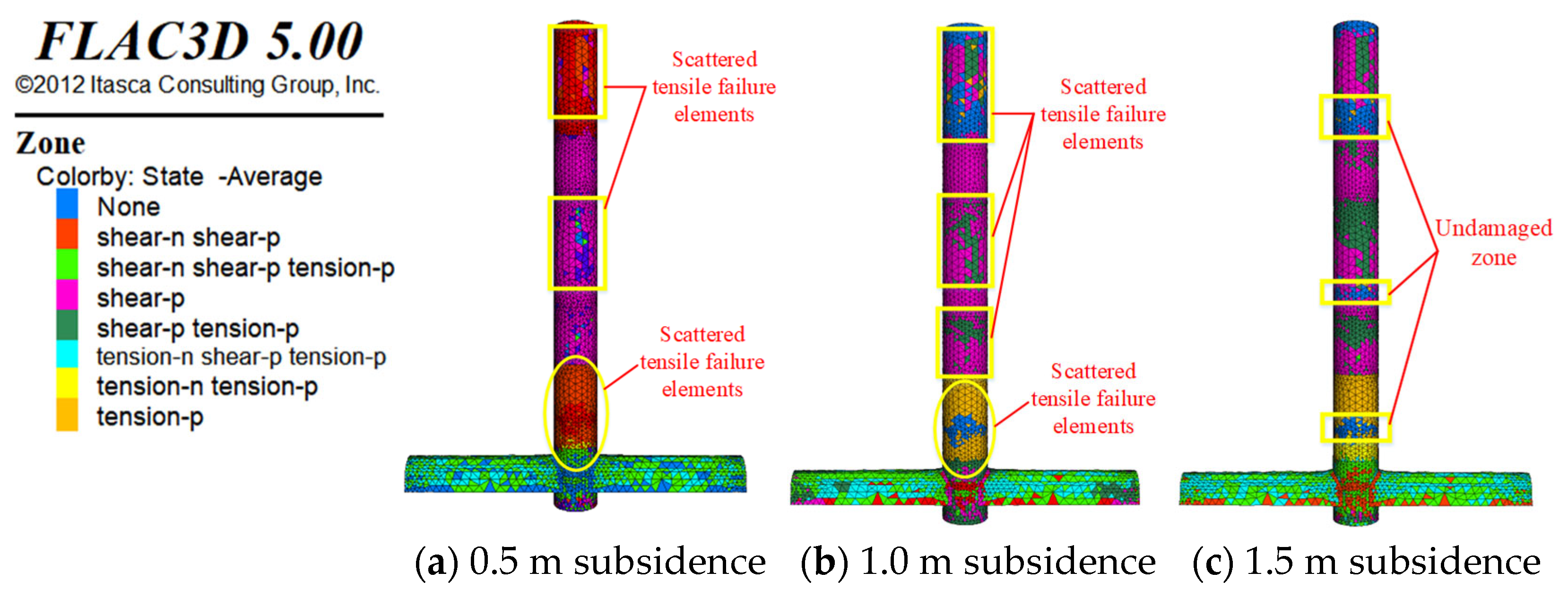

| Rock Layer | Number | Strata l/m | Thickness t/m |
|---|---|---|---|
| Weathering zone | 1# | 407 | 43 |
| Sandy mudstone | 2# | 450 | 9 |
| Mudstone | 3# | 459 | 18 |
| Siltstone | 4# | 477 | 30 |
| Mudstone | 5# | 507 | 7 |
| Siltstone | 6# | 514 | 18 |
| Sandy mudstone | 7# | 532 | 11 |
| Mudstone | 8# | 543 | 9 |
| Siltstone | 9# | 552 | 9 |
| Mudstone | 10# | 561 | 4 |
| Sandy mudstone | 11# | 565 | 12 |
| Mudstone | 12# | 577 | 7 |
| Sandy mudstone | 13# | 584 | 18 |
| Mudstone | 14# | 602 | 5 |
| Siltstone | 15# | 607 | 7 |
| Medium-grained sandstone | 16# | 614 | 13 |
| Mudstone | 17# | 627 | 10 |
| Coal | 18# | 637 | 6 |
| Sandy mudstone | 19# | 643 | 5 |
| Mudstone | 20# | 648 | 3 |
| Coal | 21# | 651 | 2 |
| Sandy mudstone | 22# | 659 | 8 |
| Mudstone | 23# | 669 | 10 |
| Siltstone | 24# | 679 | 10 |
| Layers | Density ρ/kg/m3 | Elastic Modulus E/GPa | Poisson’s Ratio | Cohesion c/MPa | Internal Friction Angle φ/° | Tensile Strength σt/MPa |
|---|---|---|---|---|---|---|
| Siltstone | 2800 | 9.95 | 0.24 | 3.8 | 31 | 0.34 |
| Fine sandstone | 2750 | 10.17 | 0.25 | 3.5 | 32 | 0.43 |
| Mudstone | 1780 | 1.7 | 0.35 | 1.2 | 33 | 0.20 |
| Coal | 2350 | 1.7 | 0.21 | 2.3 | 25 | 0.28 |
| Medium-grained sandstone | 2900 | 16 | 0.30 | 5.3 | 28 | 0.58 |
| Shaft | 2400 | 35.2 | 0.24 | 8.6 | 52.0 | 4.10 |
Disclaimer/Publisher’s Note: The statements, opinions and data contained in all publications are solely those of the individual author(s) and contributor(s) and not of MDPI and/or the editor(s). MDPI and/or the editor(s) disclaim responsibility for any injury to people or property resulting from any ideas, methods, instructions or products referred to in the content. |
© 2024 by the authors. Licensee MDPI, Basel, Switzerland. This article is an open access article distributed under the terms and conditions of the Creative Commons Attribution (CC BY) license (https://creativecommons.org/licenses/by/4.0/).
Share and Cite
Rong, J.; Wang, B. Deformation and Instability Mechanisms of a Shaft and Roadway Under the Influence of Rock Mass Subsidence. Appl. Sci. 2025, 15, 163. https://doi.org/10.3390/app15010163
Rong J, Wang B. Deformation and Instability Mechanisms of a Shaft and Roadway Under the Influence of Rock Mass Subsidence. Applied Sciences. 2025; 15(1):163. https://doi.org/10.3390/app15010163
Chicago/Turabian StyleRong, Junfeng, and Bin Wang. 2025. "Deformation and Instability Mechanisms of a Shaft and Roadway Under the Influence of Rock Mass Subsidence" Applied Sciences 15, no. 1: 163. https://doi.org/10.3390/app15010163
APA StyleRong, J., & Wang, B. (2025). Deformation and Instability Mechanisms of a Shaft and Roadway Under the Influence of Rock Mass Subsidence. Applied Sciences, 15(1), 163. https://doi.org/10.3390/app15010163






